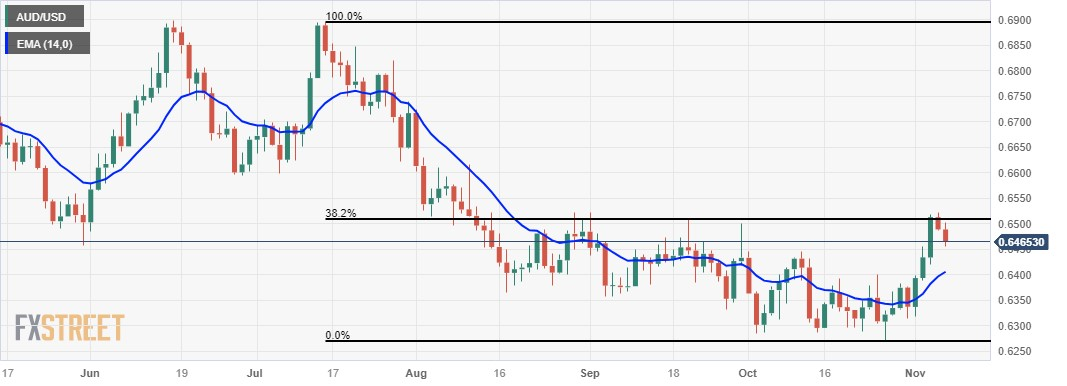- Australian Dollar extends losses amid a 25 bps interest rate hike by the RBA.
- Australia’s central bank lifted OCR from 4.10% to 4.35% after holding interest rate for four consecutive meetings.
- China’s Trade Balance reduced to $56.53B against the market consensus of $81.95B in October.
The Australian Dollar (AUD) continues to decline despite a 25 basis points interest rate hike by the Reserve Bank of Australia (RBA) on Tuesday. The AUD/USD pair also faced losses as a result of the positive performance of US Treasury yields, aiding the US Dollar (USD) in bouncing back from its two-month low.
Australia’s central bank has recommenced policy tightening, raising the Official Cash Rate (OCR) from 4.10% to 4.35% after keeping the benchmark interest rate steady for four consecutive meetings. The RBA’s decision to take this step could be a reaction to the recent Consumer Price Index (CPI) data, which showed a third-quarter increase surpassing market consensus. Additionally, Australia’s seasonally adjusted Retail Sales (MoM) for September exceeded expectations.
Investors likely pay close attention to RBA Governor Michele Bullock’s commitment to the recent hawkish stance, indicating possible interest rate hikes down the road. Furthermore, major Australian banks such as ANZ, CBA, Westpac, and NAB have revised their forecasts for an RBA rate hike in response to resurging inflation and the hawkish statements from RBA policymakers.
China’s Trade Balance data for October revealed a decrease in the surplus balance against the market expectations of an improvement. While Exports (YoY) experienced a more significant decline, surpassing the expected decrease and exceeding the previous decline.
US Dollar Index (DXY) recovers from its seven-week low due to improved US Treasury yields. The 10-year US Treasury yield has bounced back from the six-week low noted last Friday. Moreover, Minneapolis Federal Reserve Bank President Neel Kashkari, in a Monday interview with the Wall Street Journal, conveyed a cautious approach to monetary policy.
President Kashkari leans towards being overly cautious, expressing a preference for overtightening rather than risking not doing enough to bring inflation in line with the central bank’s 2% target.
Daily Digest Market Movers: Australian Dollar faces challenges despite the interest rate hike by RBA
- RBA has resumed policy tightening, raising the Official Cash Rate (OCR) from 4.10% to 4.35% after maintaining the benchmark interest rate unchanged for four consecutive meetings.
- Australia’s TD Securities Inflation (YoY) reduced to 5.1% in September from 5.7% prior.
- Australia’s Retail Sales improved to 0.2% in the third quarter from the previous reading of -0.6%.
- Aussie Trade Balance (Month-on-Month) decreased to 6,786M in September, falling short of expectations set at 9,400M and down from the previous figure of 10,161M.
- In the twelve months leading up to September 2023, Australia’s monthly Consumer Price Index (CPI) recorded a 5.6% increase. However, the quarterly inflation rate dipped to 5.4% year-on-year in Q3.
- China’s Trade Balance data for October revealed a decrease in the surplus balance at $56.53B against the market expectations of an improvement to $81.95B from the previous readings of $77.71B. While Exports (YoY) experienced a more significant decline of 6.4%, more than the expected decline of 3.1%.
- US Bureau of Labor Statistics recently unveiled the Non-Farm Payrolls (NFP) data for October, disclosing a figure of 150K. This missed the expected 180K and marked a substantial drop from September’s 297K.
- US Average Hourly Earnings (Month-on-Month) saw a decline to 0.2%, deviating from the anticipated 0.3%. On a year-over-year basis, it came in at 4.1%, surpassing the 4.0% expectations.
- US ISM Services Purchasing Managers’ Index (PMI) declined from the previous 53.6 to 51.8. Additionally, on Thursday, the US Department of Labor released the count of initial claims for unemployment benefits for the week ending October 27, showing an increase from 212,000 to 217,000.
Technical Analysis: Australian Dollar breaks below the major support at 0.6450 level
The Australian Dollar trades lower around the major support at the 0.6450 level followed by the 14-day Exponential Moving Average (EMA) at 0.6406 lined up with the psychological level at 0.6400. On the upside, the 38.2% Fibonacci retracement level at 0.6508 could act as the immediate resistance followed by September’s high at 0.6521.
AUD/USD: Daily Chart

Australian Dollar price today
The table below shows the percentage change of Australian Dollar (AUD) against listed major currencies today. Australian Dollar was the weakest against the US Dollar.
| | USD | EUR | GBP | CAD | AUD | JPY | NZD | CHF |
| USD | | 0.12% | 0.13% | 0.18% | 0.81% | 0.19% | 0.45% | 0.14% |
| EUR | -0.11% | | 0.02% | 0.07% | 0.70% | 0.08% | 0.38% | 0.04% |
| GBP | -0.15% | -0.04% | | 0.03% | 0.66% | 0.05% | 0.33% | 0.01% |
| CAD | -0.18% | -0.07% | -0.04% | | 0.66% | 0.00% | 0.30% | -0.03% |
| AUD | -0.82% | -0.73% | -0.70% | -0.66% | | -0.64% | -0.34% | -0.66% |
| JPY | -0.20% | -0.08% | -0.06% | -0.04% | 0.60% | | 0.33% | -0.06% |
| NZD | -0.50% | -0.40% | -0.37% | -0.33% | 0.31% | -0.31% | | -0.35% |
| CHF | -0.15% | -0.05% | -0.01% | 0.03% | 0.67% | 0.04% | 0.33% | |
The heat map shows percentage changes of major currencies against each other. The base currency is picked from the left column, while the quote currency is picked from the top row. For example, if you pick the Euro from the left column and move along the horizontal line to the Japanese Yen, the percentage change displayed in the box will represent EUR (base)/JPY (quote).